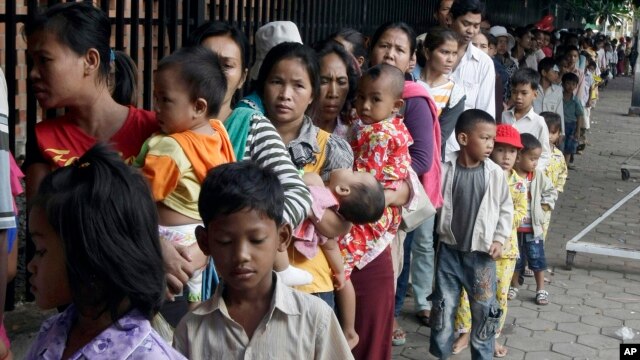Kimseng Men
January 21, 2015
Cambodia has managed to reduce poverty in many parts of the country but admits it is still falling behind on many of its United Nations development targets as a deadline to reach such goals approaches.
There are eight so-called Millennium Development Goals, aimed at improving living standards and health around the world. U.N. member countries are expected to report their progress on these goals in September.
Cambodia has managed to improve its economy, but its goals for education, women’s empowerment, child and maternal health and environmental sustainability are all lagging behind.
The national poverty rate has been cut by more than half to 18.9 percent, a goal touted by officials in Phnom Penh.
“In the past few years we have been extremely successful in reducing poverty,” said Theng Panhathun, director general of the Ministry of Planning. “This is the reason why the U.N. has recognized Cambodia as a role model in reducing poverty quickly and achieving many goals.”
Work still remains
Many challenges remain, however. Cambodia has increased the number of households using iodized salt, for example, but malnutrition among women and children remains high.
Child labor is still a concern and above the national target of 8 percent. Many children still drop out of school before the ninth grade to seek work to help feed their impoverished families.
Government officials say they are working to make improvements.
Education Minister Hang Chuon Naron said in an interview he expects a 74 percent enrollment rate through Grade 9 soon.
“We have achieved other indicators, like literacy, the net admission rate and the elimination of gender disparity,” he said.
UNICEF points out that many of the nation’s poor, indigenous or disabled are not receiving the same level of attention.
Role of women
In terms of empowering women in public life, Cambodia also lags.
“They have set the targets, but why are these not achieved?” asked Thida Khus, director of the women’s group Silaka. “This is because they don’t have special means to ensure that women receive roles and opportunities to represent the people.”
The government is aiming for women to have 30 percent representation in the legislature and 25 percent representation at the local level. Now, it's only at 20 percent and 17.7 percent, respectively.
On the issue of environmental protection, the goal is to have 60 percent forest cover. The government says the figure now stands at more than 57 percent, a number challenged by many experts. Satellite imagery from the University of Maryland, for example, shows a continuing loss of forest cover between 2000 and 2012.
In land titling, the government’s plans are stalled. The goal was to have 65 percent of the land parcels with titles by the end of this year and the Ministry of Land Management says it has distributed 3.8 million land titles. Rights groups say as many as 770,000 people have been victims of land grabs or forced evictions, something government reports do not take into account.
Important targets met
Still, Cambodia is ahead in some areas. It has successfully reduced the prevalence of HIV/AIDS to 0.6 percent, more than a full point below its 2015 goal of 1.8 percent.
Safe water in urban areas reaches 80 percent of the population, a goal the government met four years ahead of schedule.
Additionally, Cambodia has been successful in mobilizing foreign development assistance, loans and grants as part of a goal to have richer nations play their part. Cambodia receives more than $1 billion in foreign assistance annually, more than double what it received in 2001.
“This money has contributed to building big infrastructure that enables smooth traffic for commercial exchange and businesses,” said Chan Sophal, director of the Center for Policy Studies. “This has led to 7 percent economic growth annually.”
Chan Sophal said if the money were managed transparently the results could be better. “I’d say it would be more effective if the government used it more carefully, by paying close attention to quality and costs of the infrastructure built using the loan or official development assistance.”
Lowering goals
Meanwhile, the government appears to have lowered some of its goals in recent reports. Literacy for the young ages 15 to 24, once with a 100 percent goal, has been modified to 94.5 percent. Maternal mortality has been adjusted from 140 deaths per 100,000 live births to 250. Land titling has been adjusted down from 65 percent to 43 percent.
Theng Panhathun said the government is committed to achieving the remaining goals, even if it misses the 2015 deadline, “by putting in place a quick and winning framework.”
This framework includes stable economic growth, improving human resources, protecting natural resources from development, promoting gender equity and increasing access to drinking water, he said.
This report was produced in collaboration with the VOA Khmer service.


No comments:
Post a Comment